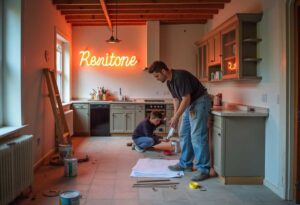Basements are no longer reserved for dusty storage boxes and forgotten furniture. With the right remodeling approach, your basement can evolve into one of the most functional areas in your home — adding usable square footage, solving layout problems, and even generating income.
In this guide, we’ll explore creative, practical, and strategic basement remodeling ideas that go far beyond aesthetics. From smart space planning and multi-use zones to building legal rental units or tech-savvy studios, these ideas are designed to turn your basement into a highly functional, fully optimized part of your living space.
You’ll learn:
- Space-maximizing layout concepts
- Renovation strategies that balance function with comfort
- Zoning tricks, storage innovations, and utility upgrades
- How to design with value, usability, and code compliance in mind
The Functional Power of a Finished Basement
A well-remodeled basement isn’t just a bonus room — it’s a problem-solver. From creating dedicated spaces for focus and relaxation to housing guests or generating income, your basement can unlock value you didn’t know your home had.
What Makes a Functional Basement?
- Daily usability: Not just pretty — but purposeful
- Multi-use potential: Flex spaces that adapt over time
- Comfort: Insulation, lighting, and layout that match above-ground standards
- Privacy: Soundproofed zones or separate access when needed
When designed around real life — not just aesthetics — your basement becomes more than an extra level. It becomes essential.
Guest Rooms with Built-In Privacy Features
Hosting family or friends? A private, thoughtfully designed basement guest suite creates comfort and separation — for them and you.
Privacy-First Features to Include:
- Sound insulation in ceilings and shared walls
- Pocket or barn doors to save space and ensure separation
- Private bathroom or powder room, even if compact
- Soft lighting and layered textures for a hotel-like feel
- Smart locks or keypad access for long-term guests or Airbnb stays
Design Tip: Keep a mini storage nook for extra towels, toiletries, and spare linens so guests feel independent — no late-night trips upstairs.
Rental-Ready Basement Conversions (Without Going Overboard)
Turning your basement into a legal or semi-private rental unit can generate monthly income, boost property value, or support multi-generational living — but it doesn’t have to be a full apartment build-out.
Essential Features for a Functional Rental Space:
- Private entrance or at least separate stairwell
- Egress windows to meet legal bedroom codes
- Compact kitchenette: Think mini-fridge, microwave, and open shelving
- High-efficiency heating/cooling split system
- Separate utility meters or secure access to shared areas
Pro Tip: Even if you don’t plan to rent right now, building to rental-ready standards gives you flexibility later — and strong resale appeal.
Combining Work-from-Home with Relaxation
Today’s homeowners are asking more from every square foot — and that means creating dual-purpose zones. Your basement can become a hybrid space where you focus during the day and unwind at night.
Smart Basement Office + Lounge Ideas:
- Wall-mounted desk with hidden cords
- Pull-out daybed or sleeper sofa for guest stays or breaks
- Neutral lighting zones – bright overhead for work, warm ambient for evening
- Acoustic panels to reduce echo and increase focus
- Storage dividers: Bookcases or cube shelves to split the space naturally
Design it right, and you won’t need to choose between function and comfort — your basement can deliver both.
Soundproof Studios for Music or Content Creation
Whether you’re recording a podcast, editing videos, or playing drums — a soundproofed basement studio can give you a space to create freely without disturbing the rest of the household.
Core Studio Features:
- Acoustic foam panels and insulated drywall
- Floating floors to reduce vibration
- Soundproof door seals and double-pane windows
- LED task lighting that doesn’t interfere with audio/video recording
- Storage racks for instruments, mics, cables, and gear
Bonus Tip: If you’re streaming or on-camera, invest in a dedicated background setup with lighting, branding, and visual interest. It’ll elevate your content and your confidence.
Game Room Meets Movie Theater — A Hybrid Approach
You don’t need a massive basement to have both a fun game room and a cozy home theater. The secret? Smart zoning and multipurpose furniture.
Hybrid Setup Ideas:
- Modular seating: L-shaped sectionals with moveable ottomans
- Projector + pull-down screen: Saves wall space for gaming gear
- Built-in shelves: Store board games, controllers, or movie collections
- LED backlighting: Adds atmosphere and defines each “zone”
- Soundbars with dual-mode audio for gaming and film quality
Tip: Consider foldable gaming tables (like air hockey or poker) to keep the room flexible when not in use.
Kid-Friendly Spaces That Grow With Them
Basement remodels that evolve with your children save time, money, and stress later. Rather than designing a “playroom,” create a space that adapts from toddler zone to teen hangout.
Design Tips That Scale with Age:
- Low storage bins now, taller cabinets later
- Corkboard or whiteboard walls for homework, art, and organization
- Built-in desk nook that can shift from coloring to study
- Durable flooring (LVP or cork) to withstand spills and foot traffic
- Slide-out toy storage beneath bench seating or stairs
Keep the space open and modular — the more flexible your design, the more years it will stay functional.
Basement Gyms That Actually Get Used
A home gym sounds great… until it turns into a glorified laundry rack. Avoid that fate by making your basement fitness space inviting, accessible, and organized.
Smart Features for a Usable Gym:
- Rubber mat flooring: Non-slip, joint-friendly, and easy to clean
- Mirrored walls: Increase light and help with form correction
- Vertical storage for weights, mats, and resistance bands
- Built-in Bluetooth speaker system for motivation
- Ventilation and a dehumidifier to keep it fresh
Even a 5×7 ft space can be highly effective with smart layout and gear choice.
Laundry + Utility Room Redesigns
Your laundry or utility area doesn’t need to be hidden behind a curtain. A smart remodel can turn these overlooked zones into efficient, organized workspaces that you’ll actually enjoy using.
Functional Laundry Space Ideas:
- Counter space above machines for folding
- Hanging rod or pull-out drying rack
- Open shelves with labeled bins for supplies
- Built-in sink for hand-washing delicates or soaking
- Durable backsplash and overhead lighting
Add some style — think subway tile or butcher block counters — and suddenly your basement laundry becomes a design feature, not an afterthought.
Pet Areas, Mudrooms & Hobby Zones
Basements are ideal for adding special-use spaces that keep messes (and hobbies) out of your main living areas. Whether you’re a dog owner or DIY enthusiast, here’s how to make it work.
Creative Add-on Spaces for Functionality:
- Pet station: Built-in crates, washing area, and food storage
- Basement mudroom: Bench seating, coat hooks, cubbies for shoes
- Craft zone or workshop: Pegboard walls, supply drawers, task lighting
- Indoor gardening corner: Grow lights, racks, and a potting table
- Model-building or painting nook with ventilation
These zones often require very little square footage — but the functional payoff is huge.
Hidden Storage, Pull-Outs, and Convertible Furniture
Basements are prone to clutter, especially when used for multi-purpose living. The solution? Smart storage that disappears into your design and furniture that adapts to multiple uses.
Smart Space-Saving Solutions:
- Pull-out drawers under staircases
- Built-in benches with lift-top lids
- Convertible sofas, murphy beds, or modular chairs
- Niches and recesses in walls for books, linens, or décor
- Storage coffee tables or ottomans
Make every inch work harder without making your space feel cramped.
How to Add Function Without Losing Style
Functionality doesn’t mean giving up style — it just means being intentional. The most successful basements are just as beautiful as the rest of your home, but designed to work harder behind the scenes.
Style-Forward Yet Functional Tactics:
- Match flooring and color palette to your upstairs design for cohesion
- Use open shelving for visual lightness and display
- Accent lighting doubles as both décor and task lighting
- Woven baskets, trays, and bins that hide clutter elegantly
- Minimalist cabinetry with sleek handles or push-to-open design
Design with your eyes — and your everyday habits — in mind.
Energy-Smart Design Choices That Pay Off
Basements often have different energy needs than upper levels — cooler temps, higher humidity, and less natural light. But smart remodeling can reduce your utility bills and increase overall comfort.
High-Impact Energy Upgrades:
- Insulated subfloor systems to reduce cold
- Spray foam insulation in rim joists
- Energy-efficient windows (or light wells)
- Dehumidifier with smart humidity controls
- LED lights with dimmer controls and motion sensors
These choices not only make your basement more livable — they make your entire home more sustainable.
Smart Tech Integration for Daily Ease
If you’re finishing your basement in 2025, you can’t ignore smart home technology. Adding automation from the ground up saves time, enhances safety, and boosts usability.
Smart Basement Ideas:
- Smart thermostats and mini-split HVAC systems
- App-controlled lighting zones and scenes
- Motion sensors for closets, stairways, and utility zones
- Integrated security cams at basement entry points
- Smart locks for guest/rental suites
Plan wiring and Wi-Fi coverage early — basements can be tricky for signals.
Design Elements That Encourage Daily Use
Too many basements end up as “out of sight, out of mind.” The key to making it functional long-term? Design it so you want to be down there — every day.
Final Touches to Maximize Use:
- Cozy textures: Rugs, throws, and warm lighting
- Natural elements: Wood tones, plants, stone
- Visual focal points: Gallery walls, murals, feature lighting
- Consistent temperature and airflow
- Comfort-first furniture: Recliners, deep cushions, and layered seating
A space designed for function is used. A space designed for comfort and function is loved.
Conclusion: Remodeling with Purpose, Living with Impact
A basement remodel is more than an upgrade — it’s an opportunity to make your home work smarter. By focusing on functionality first, you create spaces that feel intentional, flexible, and truly livable.
Whether you’re adding a gym, guest suite, office, or all three in one, your basement can become a powerful extension of your everyday life. Think beyond drywall and paint. Think lifestyle, usability, and value.
Your basement is ready. Are you?
Frequently Asked Questions (FAQs)
Can I remodel my basement in phases?
Yes — start with foundational work like moisture control and insulation. You can finish individual areas as your budget or needs evolve.
What's the difference between finishing and remodeling a basement?
Finishing means making a basement livable (walls, floors, lights). Remodeling goes beyond that — changing layouts, adding new rooms, or integrating new functions.
How much does a functional basement remodel cost?
On average, $20,000 to $45,000, depending on plumbing, electrical, and finish quality. DIY or partial upgrades can reduce this significantly.
Do I need to upgrade my HVAC for a remodeled basement?
Often, yes. A basement may need additional heating/cooling solutions like ductless mini-splits or in-floor radiant heating to match comfort levels upstairs.
Is it worth adding a second laundry or kitchen in the basement?
If it fits your goals (e.g., rental unit, multigenerational home), absolutely. It adds long-term value and daily convenience.





